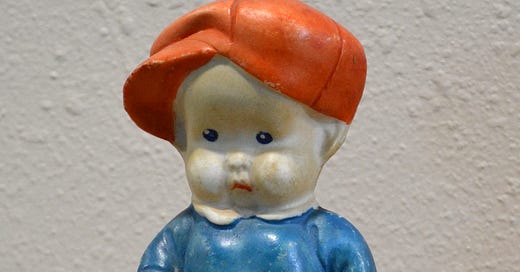“Henry” figurine. Photo by Carol Van Klompenburg
Over the next couple of months, I plan to share excepts from A World in a Grain of Sand as bonus posts. Each Friday, I will share a short chapter from one of its eight sections. Today’s chapter is from Section 1: “Heirlooms and Family Memories.”
Enjoy—and if you enjoy please use the share button at the end!
When my father, Henry Addink, died in 2014 and my mother moved to an assisted-living apartment, my siblings and I divided what she could not keep. We took turns, each of us selecting an item in sequence.
A blue figurine with an orange cap called out to me. Dad had inherited it from my grandparents, and it had stood in my parents’ curio cabinet for decades. After it had stood on our shelving for several years, I started thinking of it as Henry.
The six-inch-figurine’s brimmed cap reminded me of a softball cap and Dad’s pleasure playing that game.
He served mostly as a first baseman on our church team, but occasionally, when their customary pitcher Paul ran out of pitching steam, Paul insisted on playing first base and Dad moved to center field.
My clearest memory of Dad’s play is in this position. I was 13, and he was 36. Sitting in the bleachers, I was already embarrassed because I thought him much too old to be playing softball. He had been balding at 25, and now his pate gleamed under the ball field lights.
A heckler from a seat near me yelled, “Put out that light in center field!” The crowd guffawed. I wanted to crawl under the bleachers.
The moment passed, and ten years later, I felt proud Dad still played. In his fifties, he switched to umpiring, and when he called balls and strikes, his voice rang out as loud as that heckler’s had. Dad’s energetic aging has served as a role model for me.
Today, as I dust, I study Henry, and for the first time I notice a smooth hole in his right hand. The hole is not from damage. It is a molded part of his hand and too small to hold a bat.
What did it hold? I wonder. Perhaps a fishing pole?
I think of Grandma Addink and her love of fishing for bullheads in Northwest Iowa rivers. I picture her on her fishing stool with her line in the water. She enjoys the breeze and waits for a bite. She can’t see the bullheads, but she knows they are out there in the muddy water.
I enjoyed fishing in childhood and adolescence. I no longer fish, but I think my freelance writing is a form of fishing with words. Will editors or readers grab the word bait I cast onto the waters of the publishing world? Will readers email responses? I don’t know, but, like Grandma, I love casting the line.
I stop dusting, and I photograph Henry. I paste the photo of this softball-or-fisher boy into Google Images. About 30 almost identical images pop up with accompanying information. They are for sale.
I learn that Henry is bisque—unglazed china. He was hand painted after kiln firing. I read he was made in Japan. I check under his feet and on his back, where it says in both places, “Made in Japan.” I haven’t ever noticed this before.
Some entries call him a “frozen Charlie doll” because his arms and legs are immovably molded as part of him.
I am surprised to read his brimmed cap, a circle made of pie-piece sections, was worn by newsboys, not ball players. I sigh.
Then the information gets messy. Some owners say he dates back to the 1920s; others claim he originated the 1950s. Some owners say he is the comic strip character Smitty from Gasoline Alley.
In the Wikipedia listing for “Gasoline Alley,” however, there is no character named Smitty. When I look at samples of the comic, I find Smitty, but he doesn’t look at all like my Henry.
I wonder about that hole in Henry’s hand. One owner says it probably held flowers. In one photo, though, Henry holds a remnant of string. That owner says it is the remains of a leash, but the attached puppy has been lost. Another owner confirms the puppy and leash story. I sigh again. There goes my fishing pole story.
The information I have found is contradictory. The information may be based on an owner’s desire to sell an antique. I am not convinced about his comic strip character origins. But I am convinced the figurine stories I created about softball and fishing are probably figments of my imagination.
I created myth for Henry, not history. But the memories evoked by those myths still have power. I know that whenever I dust him, he will bring to mind my father and my grandmother along with the traits they have modeled and passed on.
Did you enjoy this post? Then please spread the news. Free subscribers always welcome. Carol
Carol Van Klompenburg is a writer living in Pella, Iowa. She has a BA in English and an MA in Theater Arts — and is available for reading performances of her work.
Reviewers are calling A World in a Grain of Sand “stirring,” “winsome,” and “delightful.”
In Pella, it is available from Carol (carolvk13@gmail.com or Pella’s Curiosity Shop. It is also available on Amazon.





That is beautiful Carol. I appreciate you sharing your story, a story where God's presence is evident. It is like the SS class I am in currently with Michele De Bruin. We have been writing and sharing our spiritual autobiography. God Bless
Thank you for sharing this story of your son's birth and the memories surrounding that time! your grief was palpable! Also the story of the embroidery and the letter from your mom! The Lord bless you and keep you!